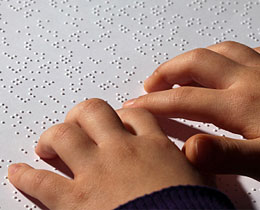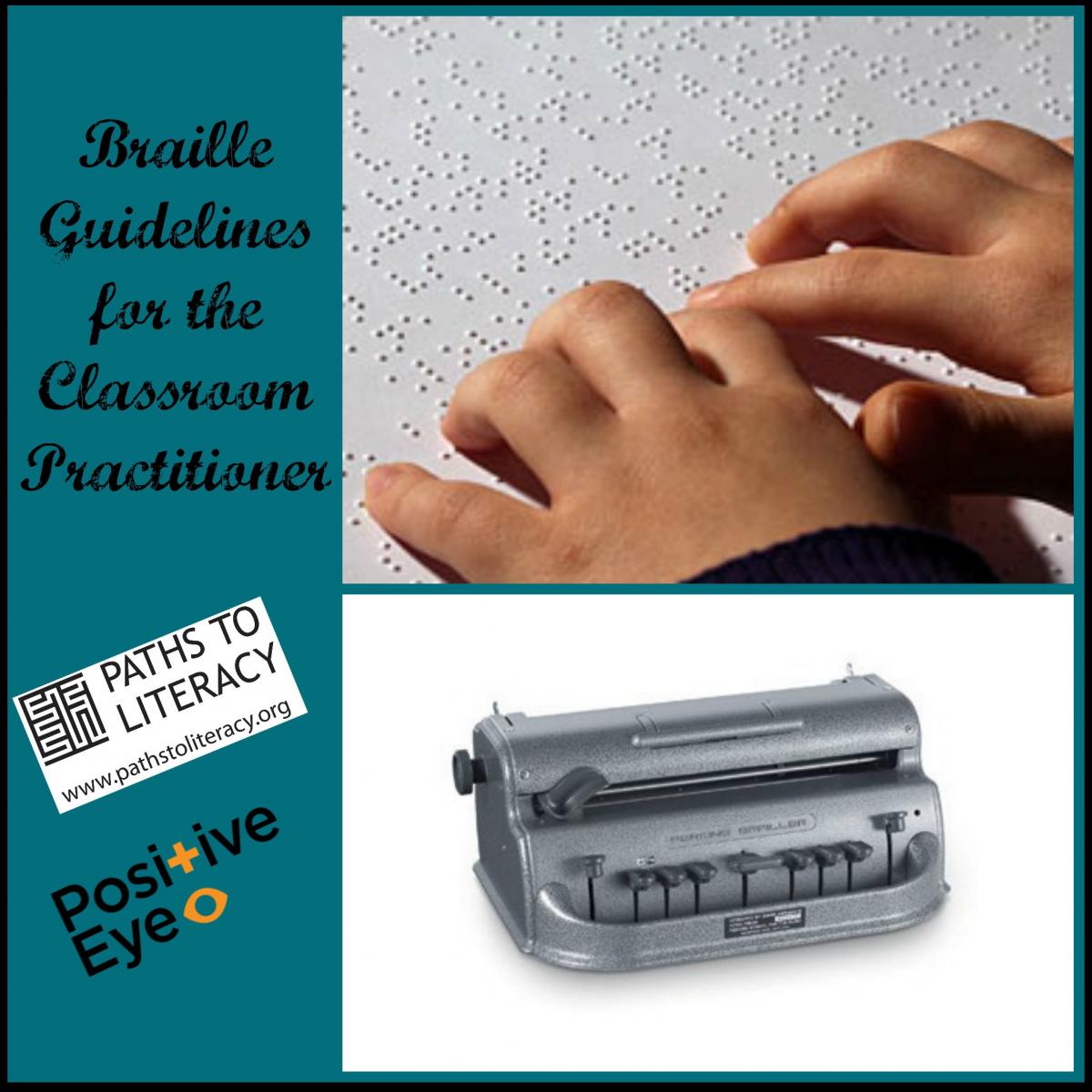
Resource
Braille Guidelines for the Classroom Practitioner
These guidelines for braille are designed to promote awareness among practitioners in inclusive settings. Tips will be helpful to general education teachers & others who may not have previous experience with braille readers or children who are blind.
Like many other professionals, during my practice as a Teacher of VI, I always aimed to bring everyone to same the ‘hymn sheet’ to share common practice and to understand together the roles and responsibilities in supporting a child. Here I share my Braille Guidelines for Classroom Practitioners, aimed at those in mainstream settings. Each setting and situation is different and guidelines need to be tailored as such. These are guidelines I have delivered and also used as part of Positive Eye courses, they can be amended to suit your situation.
Part One: General, In Class
- Learning outcomes set for the class need to be the same for and fully inclusive of the child, his/her route to reaching the learning outcomes will require adaptations and modifications to ensure accessibility.
- High expectations need to be set based on his/her cognitive ability and not governed by his/her visual status. This is important in ensuring the Child is stretched academically and his/her potential is maximised.
- Braille is a tool used by the child to enable access; it should not create a barrier to learning. The child may require more time to access Braille/tactile materials, to enable him/her to process the information and internalise concepts. This is due to the complexity of accessing information through tactile materials and is not connected to his cognitive ability.
- The child needs the same access to text as sighted children experience. The presence of braille needs to sit inclusively and equally alongside other children’s print access.
- If the other children are requested to read print as part of a task, the child needs to have his/her own braille version to access the same information at the same time. E.g. the Child should not be listening to learn when others are involved in learning through looking at/reading text.
- All text needs to be adapted into braille/tactile format according to the child’s current level of braille knowledge.
- The child’s level of braille knowledge will continue to develop on an ongoing basis over the next school years, maintaining a weekly record of his/her developing skills, e.g. reading/writing of the code, knowledge of contractions, will help to chart his/her progress. This will also ensure everyone involved in the adaptations of the curriculum are aware of the level of braille to prepare materials in.
- Goals will be set, reviewed termly and targeted interventions will be delivered through the child’s weekly braille programme.
- Spelling tests: child needs to spell the words out and present his/her answers in uncontracted braille. The child can then add contracted Braille versions alongside as he/she learns the code.
- (KS1/2) Braille, like print at this stage, needs to be supported by tactile images or real objects or models. Whenever a picture is used to give meaning to, add interest to, or support print literacy, it should be considered how the child will be given access to this.
- It is important for the child to have the same opportunity for free independent and spontaneous writing as the other children in the class. The Perkins Braille Machine, along with the child’s writing tools and resources need to be set out in the classroom in a location where they can be accessed independently throughout the school day.
- Work produced by the child will need to be transcribed by the Special Needs Assistant for marking by the teacher. Alternatively or additionally, the teacher can ask the child to read back work, to check knowledge and understanding of the topic being taught. This encourages the child to read their work back. It is also an instant method for the teacher to check the child understands, without reliance on someone else to translate what he/she has written.
- Listening skills are important to support the child to understand the lesson and actions taking place around them, however they should not be relied on as the main way of accessing information, nor should they be a replacement for having information presented in braille format.
- The child will need key words displayed on the interactive board presented in Braille format. This will enable the child to follow information presented on the interactive board, at the same time, as the other children. (The teacher also needs to say what is being written or pointed to on the board to support the child’s access.) Provision of the keywords for the child to read beforehand would further support this access.
- Adapting the curriculum to ensure it is accessible for the child takes thought and time. Braille and tactile materials are time consuming to produce. It is also important that the child’s access is streamlined to ensure that materials are appropriately adapted to enable him/her to reach the learning objective with the minimum of access, whilst ensuring maximum opportunity for success. Facilitating this relies on time being made available for the Special Needs Assistant to liaise with the class teacher and with other staff teaching the child. This needs to be on a regular basis and ahead of the week’s curriculum schedule. This will ensure there is time to collect together the resources required and to enable appropriate Braille and tactile adaptations to be completed.
Part Two: Developing Braille Reading and Writing Skills
- Ongoing exposure to the initial letter sounds and developing knowledge of the braille alphabet, both to read and to write it, will support the child’s access in whole class literacy work, ensuring he/she can take part in phonics work etc.
- Formal teaching of the braille code needs to run alongside the child’s participation in the school’s literacy curriculum, which he/she will access according to the level of braille reading and writing he/she has reached at the current time.
- Braille lessons will be taught by ______________
- Braille sessions will be held __________________per week.
- The braille reading scheme “Hands On” will be a main tool used to teach the child. It will be supplemented by story books written at the level of braille the child is at, to help consolidate the braille code at that stage.
- To consolidate the child’s’ knowledge and enjoyment of reading, books from the school’s reading scheme can be adapted into braille. These will need to be adapted according to the level of code he/she is currently at and will need to be adapted on an ongoing basis, (rather than ahead of time).
- Developing the tactile discrimination skills required to read braille will be an ongoing and developing skill as the child continues to refine these and learns those required to interpret tactile diagrams and images, keys and tactile representations. This is something that the child needs to work on at school through environmental exposure as well as adaptations to class materials.
Organisation of Braille
- There needs to be a designated space in the classroom where the child can keep his/her equipment and space to use a Perkins Braille Machine.
The child needs a space that he/she can access away from the noise and activity of the classroom. Some of the child’s focussed braille work will need to be done in this environment as it requires a lot of concentration from the child. - To support the child’s retrieval of information, he/she needs to develop a high level of organisation skills. This is an important long term skill to develop and commencing and supporting a system of organisation now will help the child to store and retrieve information methodically. E.g.
- Child needs to be able to set up his/her own workspace where he/she needs it and have easy access to everything he/she needs to do this
- Create folders for each subject, with labelled dividers according to the topics being studied
- Work needs to be stored using the same system, in each file, for each subject area, e.g. date order, last piece of work done on top in the file
- File the child’s written braille responses with the adapted resources that accompany the topic being studied. Keeping all items together that relate to the work done will help him/her when referring back during editing, review and later on with revision
- Folders stored in the classroom, need to be accessible to the child to enable independent retrieval
Braille in the Environment
- Ensure objects, storage units; folders are labelled with braille to support the child’s independent access. Ensure the child knows the items which have been labelled, their location and how he/she can access them.
- Classroom displays should include braille alongside the print labels. Consider the accessibility of this braille and try to have it within reach so that it can be read.
For additional ideas and resources, see http://www.positiveeye.co.uk/

